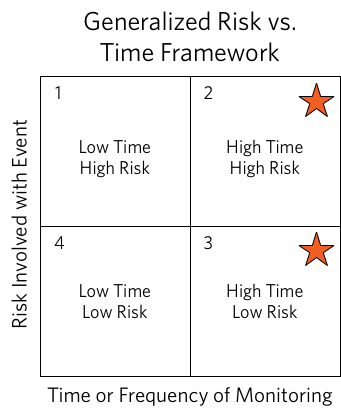Like anything else in its early lifecycle, the Internet of Things (IoT) has a ton of hype but there are still a lot of unknowns when it comes to the actual business value. Maybe you heard C3 IoT advertising on NPR, maybe your electric utility put a smart meter on your house, or maybe you got a chuckle from Juicero. So, what is the actual business value of IoT, and is it really as simple as just throwing a wifi card in your crock pot and dumping usage data into S3?
The glib and somewhat unhelpful answer is that the value behind IoT is totally dependent on your imagination and your particular business, which is why so often IoT articles are focused on industry verticals, such as manufacturing, transportation, and energy. Imagination comes into play since the cost of sensors and storage is so low that just about anything is able to be monitored. This creates a sort of decision paralysis, especially when you get bogged down by the feasibility side of things. So, what we need is a framework for dreaming up IoT value based on actual problems without worrying about feasibility.

In this generalized Risk vs. Time framework we focus on one of the core strengths of IoT, reducing the time or frequency that humans spend on monitoring, and applying that to the risk associated with the event either happening or not happening. Of course there is a big difference between the actual amount of time spent by humans on monitoring and the ideal amount of time that could be spent on monitoring if money and attention spans are not part of the equation. Offloading monitoring activities to a sensor lets human resources focus on higher value-adding activities.
In order to provide a little more context here are some examples using three scenarios, all of which are great use cases for IoT.
- Manufacturing Scenario: Packaging Machine
- Task: Monitoring the glue level in a packaging machine.
- Current monitoring: A worker reads a gauge hourly and notes it on a clipboard, which is manually entered into a spreadsheet at the end of the week, time permitting.
- Ideal monitoring: Continuously.
- Risk involved: If caught by QA, packages not being glued together would impact scheduling and order fulfillment. If not caught by QA and the package leaves the factory, there is a risk of damage and customer dissatisfaction. Medium to high risk.
- Transportation Scenario: Parking Pass Dispenser
- Task: Monitoring the number of failed parking pass transactions.
- Current monitoring: Never.
- Ideal monitoring: Continuously.
- Risk involved: If tickets do not dispense correctly there is lost revenue, customer complaints, and requests for reimbursements. Medium to low risk.
- Energy Scenario: HVAC System
- Task: Monitoring the vibrations of the compressor spindle on a building’s HVAC system.
- Current monitoring: A service company checks the system once a year.
- Ideal monitoring: Continuously.
- Risk involved: Failing bearings could lead to anything from higher energy use to equipment failure damage. Medium to high risk.
Going back to the quadrants, IoT shines is in quadrants Two and Three, where the time spent in monitoring is (or should be) high. Automated monitoring of these processes reduces the human time costs and allows for rules to be set up for notifications or actions. Generally speaking a sensor monitors the object, the object communicates data to the cloud, and the cloud logs data and applies rules to it. Rules could be sending an email, Slack or SMS notification, sending commands to a system, or to simply flag the data for review or reporting.
This is how these three scenarios play out with IoT solutions.
- Manufacturing Scenario: Packaging Machine
- Sensors: A load cell is placed under the hopper measuring the weight and implied glue level and feeds data to the cloud.
- Rules: Weight is continuously logged for process analysis and when it drops below a threshold value a Slack notification is sent to the production manager.
- Business Outcome: Fewer hours are spent on filling and checking a hopper allowing the manufacturer to integrate this process into its Kanban system.
- Transportation Scenario: Parking Pass Dispenser
- Sensors: An optical sensor is added to the dispenser as a check for paper ticket printing and data is fed to the cloud.
- Rules: A weekly report is created for all machines on a per-city basis which informs maintenance dispatch schedules.
- Business Outcome: Lowers lost revenue from misprinting machines, reduces complaints, and provides a pre-made report to share with city stakeholders.
- Energy Scenario: HVAC System
- Sensors: An accelerometer with a low pass filter feeds vibration data to the cloud.
- Rules: If vibrations are bit above the normal range indicating service is needed, email the building manager and carbon copy the local repair shop. If they at a dangerous level, send a shut-down signal to the unit, text the building manager, and email the local repair shop with a priority ticket.
- Business Outcome: Expensive repairs are avoided and client satisfaction is maintained. Automated ticket routing to the local repair shop ensures that repairs are made even if the building manager is on vacation.
Any process that either currently or ideally involves a large amount of monitoring is a great candidate for an IoT solution. Even if it is not a critical process, there is a ton of value in understanding what is going on with a system over time, informing how much human time you actually need. The monetary value of each solution will change on a case-by-case basis, but generally there is a reduction in monitoring costs and either an increased uptime or decreased downtime of processes.